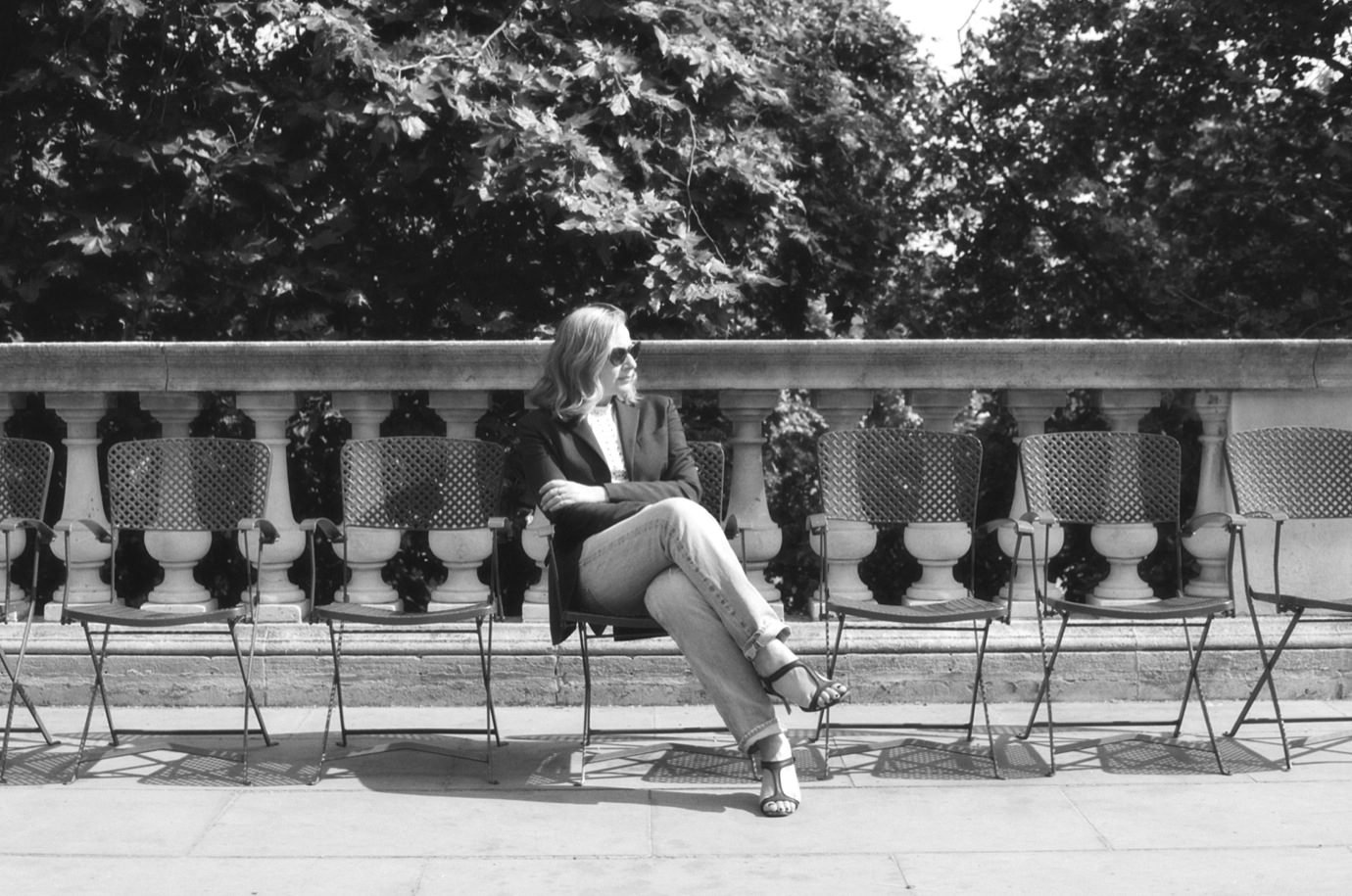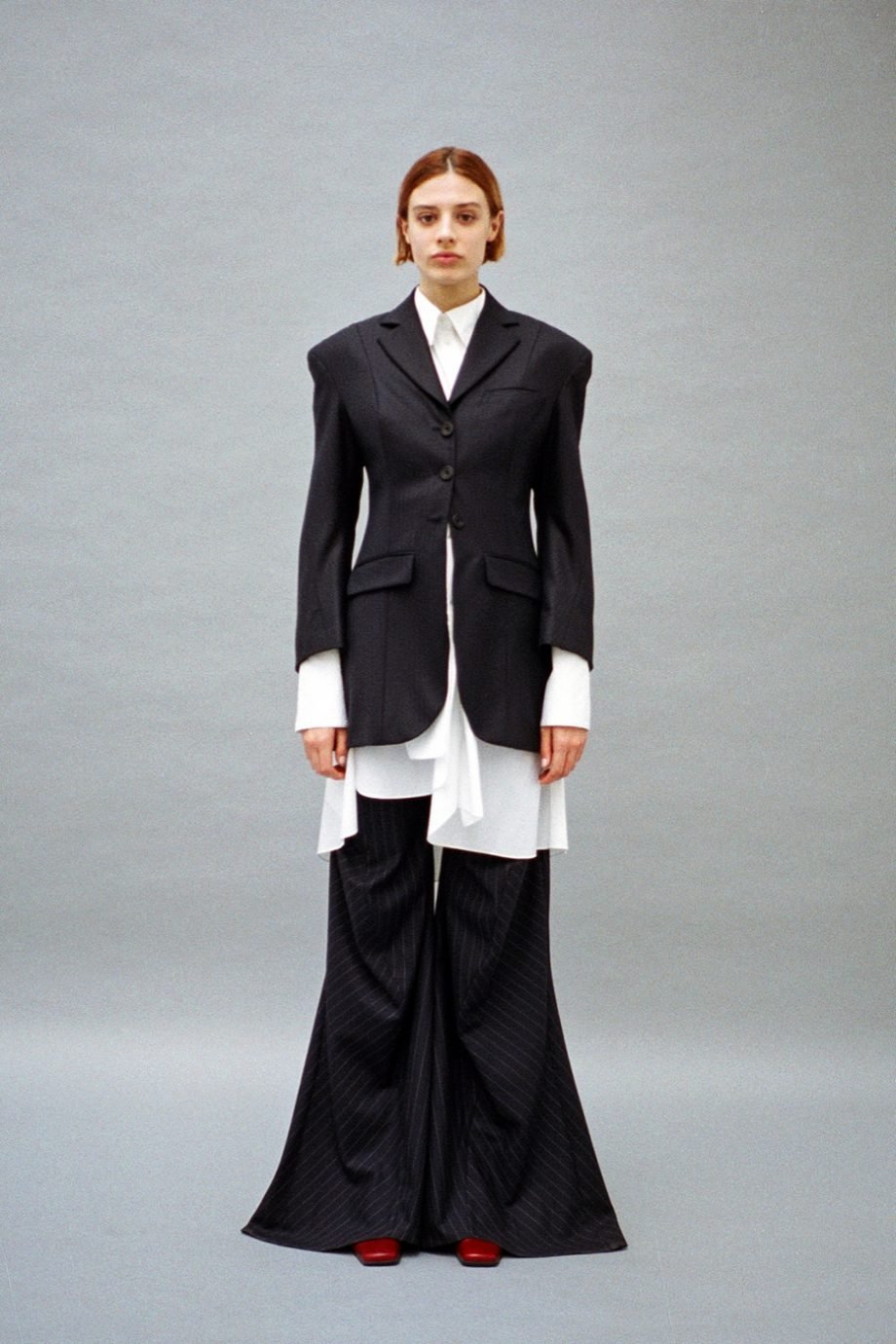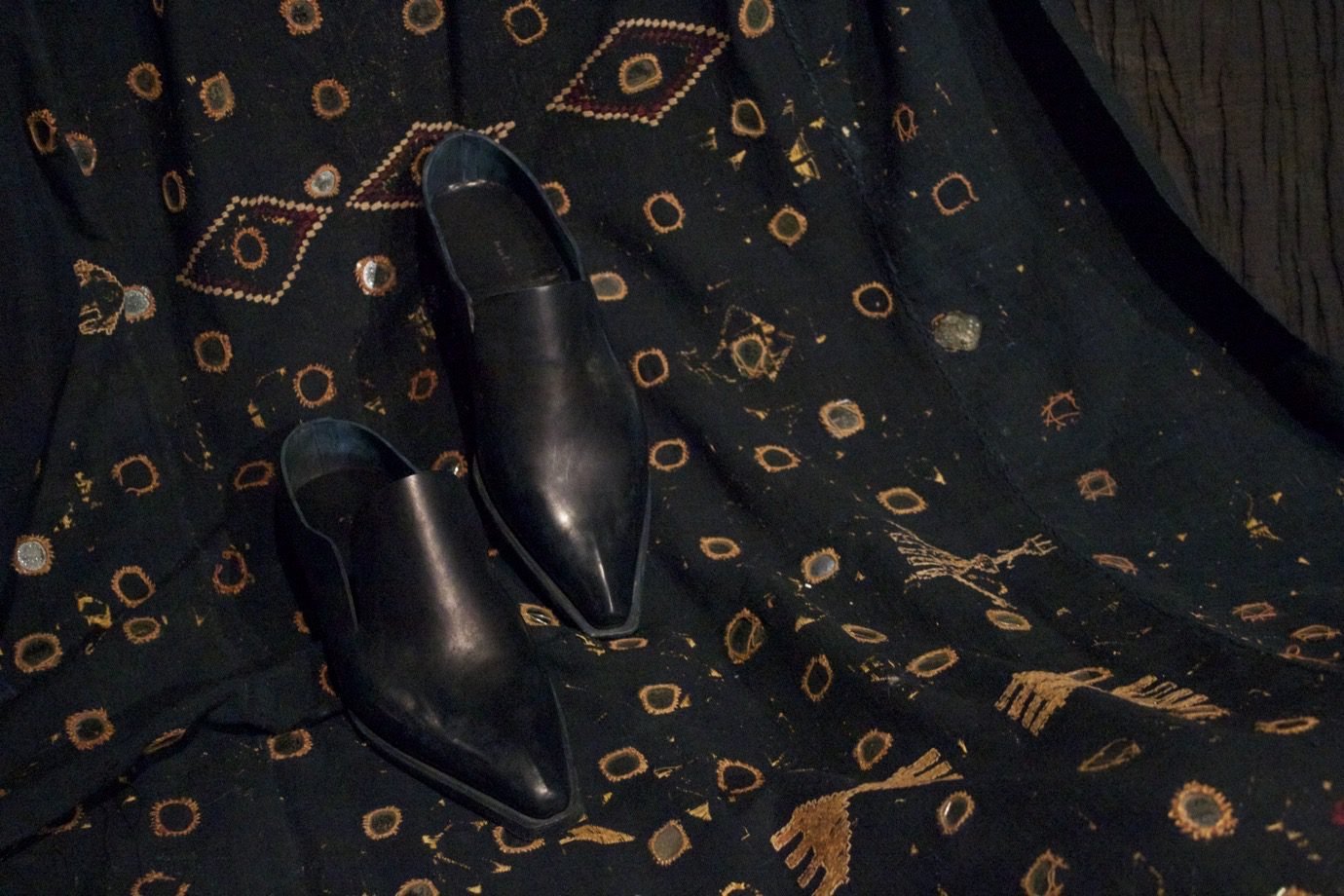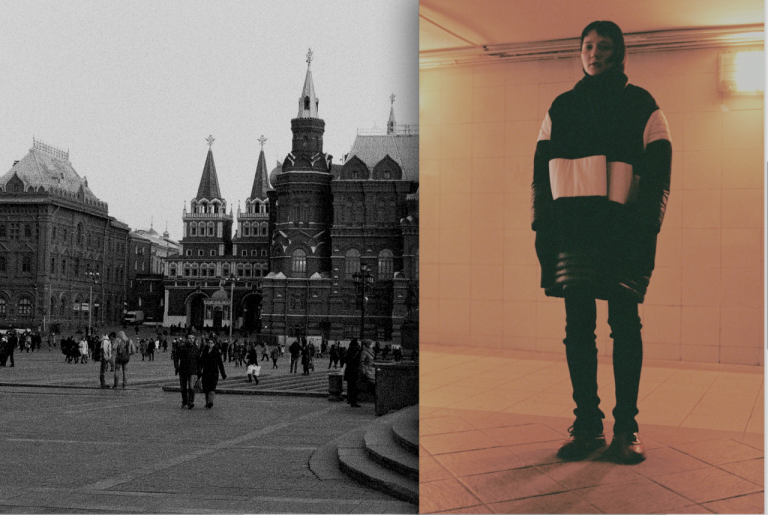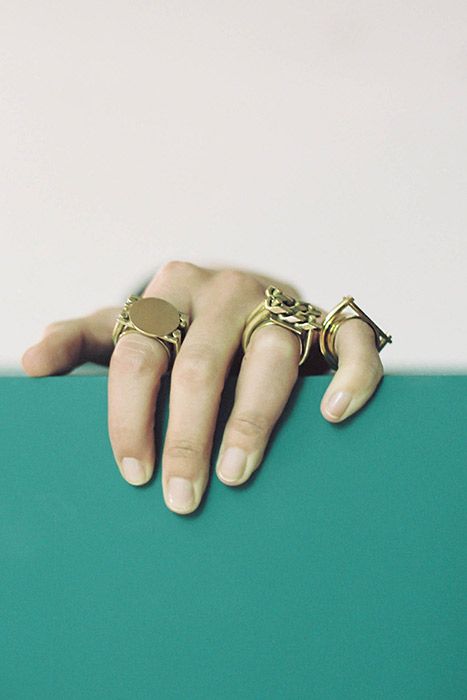Long before fashion blogs and e-commerce became the raison d’etre of online fashion content, there were Sarah’s sagely penned reviews for Style.com, then the digital home of American Vogue. Prior to a plethora of international fashion prizes, there was NewGen and London SHOWrooms, her brainchild that set the bar for other fashion economies to do the same. When London Fashion Week became a sparkling cocktail of international brands, emerging designers and the odd wildcard, Sarah was at the forefront of a silent campaign to bring the spotlight back to Britain’s capital.
Of course, none of this is ever proudly recounted from Sarah’s lips – she is the height of modesty and I sense that she’s more interested in what there is to be done than what has already been achieved. We meet in Mayfair, a stone’s throw from the standalone boutiques of Roksanda Ilincic, Christopher Kane, Erdem and Nicholas Kirkwood: all designers that she has fostered with her tireless support.
Fond of tailoring, Sarah is dressed in a sharp navy Prada blazer, a lightly checked cotton shirt worn unbuttoned underneath, and trousers that make her stand tall and serious in polished leather stilettos. Her tortoiseshell sunglasses stay on to a degree of intimidation, but after a few minutes any sense of tension floats away as she speaks passionately and discursively about the current state of fashion.
The interview that followed, which took place over a couple of hours, has been edited to represent the wide scope of our discussion, from the state of arts education to the format of the fashion calendar and the shifts in the way that fashion is understood and communicated. Who could ask for more?
“IT’S NO GOOD IF COMPANIES AND INDIVIDUALS COME ALONG THINKING THEY’RE BEING AWFULLY GENEROUS JUST BY PAYING FOR FEES. THAT’S ALL VERY WELL, BUT THEN YOU’VE GOT TO LIVE, BUY MATERIALS, AND FIND SOMEWHERE TO LIVE.”
ART SCHOOL IS WORTH FIGHTING FOR
There’ve been a number of discussions about the state of arts education recently and a lot of ideas exist around what it means to be a fashion or art student today….
Since the coalition government got in and the fees went up to £9,000, I realised that for our industry here to keep flourishing, we need to keep the pipeline – the route into excellent education in fashion – open to everybody. When I think about the landscape of British fashion going back to the 80s, it’s very hard to think about public school people as game-changing fashion designers as the culture of British fashion comes from people from all kinds of backgrounds. I became very frightened and I had an ominous feeling that that diversity would kind of stop because it’s so expensive. Also, I’m a parent now with a university-age kid. I know how all parents, as well as their children, have to really think about whether this is going to be a viable career, and because of the image of it in the outside world lots of people think fashion is not worth investing in as an educational pathway. In fact, there are skills shortages in many areas of fashion and many career paths from pattern cutting to merchandising which are wide open.
I know you’ve recently been working on developing the British Fashion Council’s ‘Business and Education Pillars Trust’. What are you doing for students and how do you feel about the state of arts education in 2015?
We realised that we needed to expand the BFC’s function as a supporter of talent from the very, very beginning – even school pupils. When Princess Diana died, there was a foundation set up called something like the Princess Diana Memorial Fund –I can’t remember what the exact name was – but anyway it was in her memory and it was for MA students in particular, and that went on until last year. But then we realised that actually MA is too late if we want to support those people – you need to catch them at BA or even before, on foundation. We need to communicate to school kids that fashion is an industry where there are lots of different kinds of jobs besides fashion design.
What was left of the Princess Diana fund was rolled into the British Fashion Council’s Education Pillars foundation. I’m a trustee and co-president of it with Mary-Beth Parker, who is the publisher-in-chief of Hearst magazines. Between us, and Simon Ward of the BFC, we’ve been raising money from individuals and companies. As soon as you say “Actually you’re not going to have the talent coming through”, they totally see the point. We have had generous donations from Coach, Net-a-Porter, M&S, Charlotte Olympia and others already. So yes, we’ve already gathered a certain amount of money and we’re going on a big drive next year to make it very public.
So is that going into scholarships and bursaries?
Scholarships, yeah.
And what about the other things like materials and housing and the other costs of being a student? Is that something that’s on the agenda?
Well the scholarships we will give, I mean I can’t promise that there will be an enormous number of them but the principle will be if you’re that deserving a person, we will cover the fee and accommodation – my friend Louise Wilson taught me that it’s no good if companies and individuals come along thinking they’re being awfully generous just by paying for fees. That’s all very well, but then you’ve got to live, buy materials, and find somewhere to live. It’s a great detriment to education. It’s fine to have a little bar job but if you’ve actually got a full-time job, or a night job or a weekend job, and all of those things just to be able to live and pay for yourself, then you’re not able to study. And we’ve seen people in really bad situations. So yes, we will be providing grants for living costs as well.
“I’M ASSUMING THAT YOU CAN FILL A LECTURE HALL FULL OF HUNDREDS AND HUNDREDS OF PEOPLE AND YOU CAN HAVE ONE MAN OR WOMAN STANDING AT THE FRONT WITH THE WHATEVER IT IS AND THEY LEARN. YOU CAN’T DO THIS WITH ARTS.”
CREATIVITY RESULTS IN CAPITAL
Every year there are about 8,000 womenswear BA graduates in the UK and there just aren’t that many jobs. Is art school becoming a luxury product? What do you think about the huge disparity between the number of students and amount of work that’s out there?
First of all, we do have a unique tradition and heritage of the British art school, which is precious and based on amazing principles: post-war principles. There isn’t anything like it in the world. And we should really, at all cost, be preserving what’s left of it, protecting it because this is what our country’s excellence is based on. Creativity is what goes into the reputation of the capital in this country, this incredibly dynamic and forward-thinking country and, basically, creative arts make money for us! But things have started to go awry when the art schools were amalgamated into universities – that’s another thing I’ve learnt from Louise and from observing. When you have universities, you can teach –I don’t know how many people you can teach Maths to because I can’t do Maths, I failed my GCSE Maths [laughs]– but I’m assuming that you can fill a lecture hall full of hundreds and hundreds of people and you can have one man or woman standing at the front with the whatever it is and they learn. You can’t do this with arts. You have to have studios. You have to have people making things. You have to have facilities in order to make these and you have to have technicians and the rest of it. That is not like a university.
So now what we have is all the so-called standards bluntly applied to art colleges. They’re now trying to say that all university teachers should be qualified with PhDs; if that is going to be true, this generation of amazing art, design and fashion teachers either retire or just leave because they’re so disillusioned and there isn’t going to be anybody to replace them. Fashion people, painters and such like, do not have PhDs: that’s fundamentally nonsense.
Then there’s this overcrowding thing that I really don’t approve of – the idea that education is a commercial business and they should just pack as many people in as possible while behaving as if the teaching staff are functionary state employees. Do you know what I mean? Am I making sense?
You are! There are far too many students and the CSM King’s Cross building is great but it’s so big and it’s kind of designed so that all of the departments are very separate. Immediately when you go there, you get this sense that it’s very empty yet there’s thousands of students.
It’s hard to fill the atrium space, any work that’s in there is automatically made to look small – it’s hard to make an impression. It’s not like Charing Cross used to be. Did you ever go there?
I did before it closed, but I was actually in the first year of the Granary building so I missed out on being taught there.
Well, nothing is perfect. It’s always very hard and it’s always highly competitive. Central Saint Martins has always been that way. From the very start, anytime I ever interviewed a Central Saint Martins graduate, ‘What’s the secret of this Holy Grail, this thing that’s imparted in Saint Martins?’ Well they say, they don’t teach you! [Laughs] So I suppose that tradition is carrying on! It’s kind of dog-eat-dog, well it’s not dog-eat-dog but you have to be. You do in order to be able to survive.
In this business, you have to be totally driven and detailed and then you will get through. I’ve always said, ‘Fashion isn’t a job, it’s a life’ – if you’re not prepared to give over your entire life to it then you probably shouldn’t be doing it. But going back to what you said about numbers – there are far too many people studying to be womenswear designers. It would be far better if there were only a few well-funded centres of excellence, all around the country, and the different offers were clear and only a limited number of people would be allowed in, purely on the basis of talent. Creatively, though, it feels like womenswear has run out of steam, especially at Central Saint Martins, I hate to say.
Why do you think that is?
It’s become so commercial, so unappealing, so meaningless, so unpoliticized… I mean I can understand why people are attracted to fashion but I mean you and I are the same: we knew that we couldn’t ever possibly have the patience to cut a pattern or be a designer, but people in general are attracted to fashion, to dressing up, to knowing about it. A lot of them just go into designing because they think they could be designers and they think that’s it. We need to be training people who can do production, sales, marketing. The trouble is that there are lots and lots of courses with those names on them. And it does break my heart because, as a parent, when I plug in fashion into the UCAS site, hundreds and hundreds of those kind of courses come up but how many of them are any good? I don’t know and I don’t know how the kids are supposed to know.
So this is another kind of mission of mine, to find these courses (and a lot of them are probably going to be outside of London), and just find where the centres of excellence are and help support and lead those teachers and units to help direct people into those areas. It’s not a theoretical thing at all – you can of course have a career. We’re sitting here in front of Selfridges. You know there’s LVMH, Kering and all of those abroad, but there’s also the generation of British fashion designers: Christopher Kane, Mary Katrantzou, Peter Pilotto, and J.W. Anderson. All these people said they couldn’t hire people with the right skills in those support and business areas. They’re stuck. They have to find and get people from abroad. People don’t want to move here because it’s so expensive in London. There’s a yawning gap between the output of art colleges and the reality of the marketplace.
“CREATIVELY, THOUGH, IT FEELS LIKE WOMENSWEAR HAS RUN OUT OF STEAM, ESPECIALLY AT CENTRAL SAINT MARTINS, I HATE TO SAY.”
MENSWEAR IS BREAKING MORE BOUNDARIES
Why do you think that menswear is more interesting than womenswear?
Because there’s a market for it. There’s been this dawning and a big generation shift, and again it’s something that London has been really good at articulating because it’s what boys have felt: it’s that new androgyny unisex, whatever you call it, gender-neutral thing going on so menswear now has a lot of the excitement and feels like it’s in a frontier which womenswear doesn’t have. Womenswear has been stuck in cocktail hour for the last 10 years.
Simultaneously with that you have all the emerging markets in Asia where you have rich young men and rich older men who want to dress and show off tailoring with, you know, expensive watches and everything else. So both of those things coming together creates a sort of interesting critical mass of a culture that’s been moving really quickly. And I see it when I go into the RCA; Ike Rust, who’s sort of the Louise Wilson of menswear, he’s amazing and has a studio full of designers and probably half of them now are girls. In the past, girls would have designed for girls, but they’re not interested. Some of the most exciting young women are designing for the guys, and guys are designing for guys. And finally in London, thanks to Dylan Jones, it was possible to bring Jermyn St. together with the young end and, London being very collaborative, they built on the back of what we’d done in womenswear and suddenly the menswear industry worldwide wants to belong to the London club of where that’s happening, so I think that’s why. Obviously it’s to do with money – it’s to do with the shift in generation and the rise of the capital is always behind fashion somehow. I mean, what do you think? It must have changed even when you’ve been growing up.
Absolutely – it’s such a big part of fashion now and appeals to so many different people. What I’ve always found interesting is the difference in men’s and women’s magazines and when I’ve written about menswear it has to be such a different tone. On one you hand, yes there’s this new frontier but if you open GQ or Esquire you just don’t get a sense of it or this new man on the horizon. It still seems so slick and banker-y.
Well it is. I mean there’s the institutional sexism of Fleet St. As soon as you start writing about menswear or someone starts writing about menswear, it’s all a joke. Men in there just think it’s a joke. And probably even men who secretly like it have to adopt a joke-y low-key tone. It’s absurd. I mean that affects womenswear as well. There’s definitely a dumbing down. I mean what can you buy on the high street this week? But yes, it is very interesting that. Going back to that, that’s why it needs to be done in an exhibition or something, so it’s nuanced and layered.
“AND IT DOES BREAK MY HEART BECAUSE, AS A PARENT, WHEN I PLUG IN FASHION INTO THE UCAS SITE, HUNDREDS AND HUNDREDS OF THOSE KIND OF COURSES COME UP BUT HOW MANY OF THEM ARE ANY GOOD? I DON’T KNOW AND I DON’T KNOW HOW THE KIDS ARE SUPPOSED TO KNOW.”
FASHION IS AT THE FOREFRONT OF MASS CULTURE
I remember a piece you wrote a few years ago for a British newspaper that was about the fashionable careers in different decades. In the 60s, everyone wanted to be an air hostess; in the 80s, everyone wanted to be an executive and in the 90s, everyone wanted to be in PR; now in the 2000s everyone wants to be a stylist or work in fashion. It seems that fashion has definitely become quite an aspirational career in that it’s so much more accessible and, like you said, there’s just a bigger demand to be a part of it and to be in fashion for fashion’s sake. I wonder how much that has to do with what you said before about womenswear design becoming redundant?
Well, fashion seems glamorous now. It’s so cheap at one end and so extremely expensive on the other. When I first started, we couldn’t afford it – we never really expected to as students. When I walk into any college and I see someone dressed in head-to-toe Louis Vuitton, to me that is somebody who has not got any credibility. I know it’s a syndrome: I’ve been seeing that creeping in probably over 10 to 15 years actually. Sorry I’m off on another track–
I think that has a lot to do with it. I think especially from your point of view, what are the big shifts you’ve seen when you go into colleges? I was speaking to a designer the other day and he was saying that he gets applications for internships from 14-year-olds. That made me think well perhaps it has more to do with why people are going into fashion and whether it’s for the wrong reasons…
It’s because of a Kardashian-Kanye West factor, isn’t it? It’s part of pop culture and entertainment now. Kids know who Olivier Rousteing is and they even know how to pronounce his name because it’s on Instagram. That just is what it is – I’m not knocking it. What I’m saying is, does that actually sell any clothes? I don’t know whether it can be quantified and how valuable that kind of fame really is in terms of making people buy clothes. It’s very, very mass, and if the awareness is very mass, it’s the very nature of it. I mean, what can teenagers buy?
But I suppose on one end you could say that actually, considering it in a digital context, it’s purely about the sale of clothes because compared to pre-Instagram and pre-social media you don’t get that daily update of so and so’s wearing this and it’s completely linked so in one easy click, oh look there it is on Net-a-Porter! I think that it has a lot more to do with the sale of clothes rather than someone who is considered stylish but not necessarily wearing something that is hitting stores in the next three months…
Yeah but it goes back to what you say, why do people want to study fashion?

